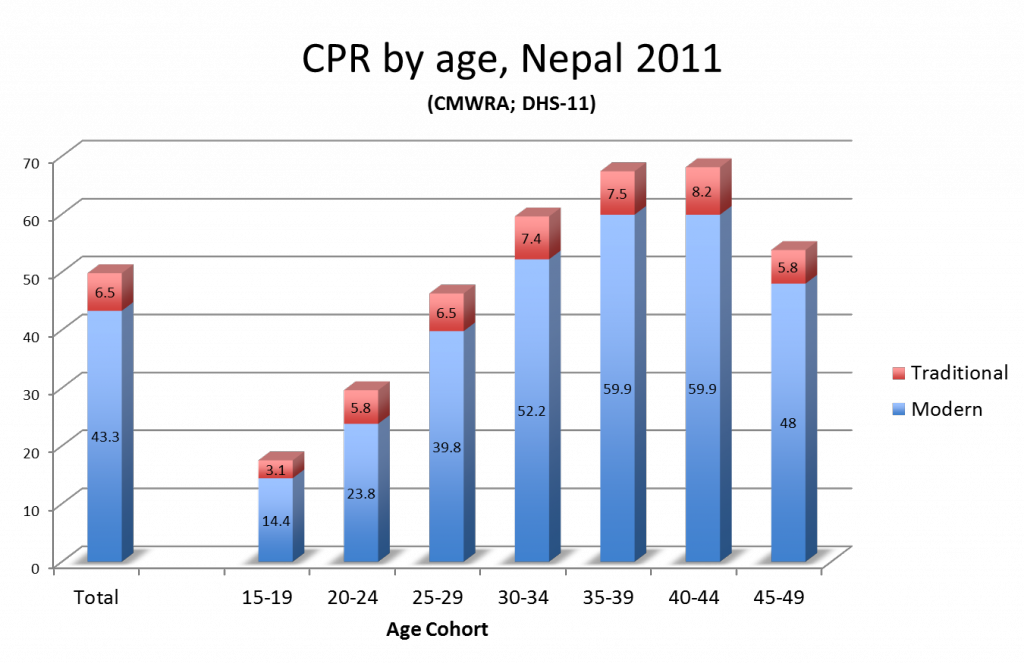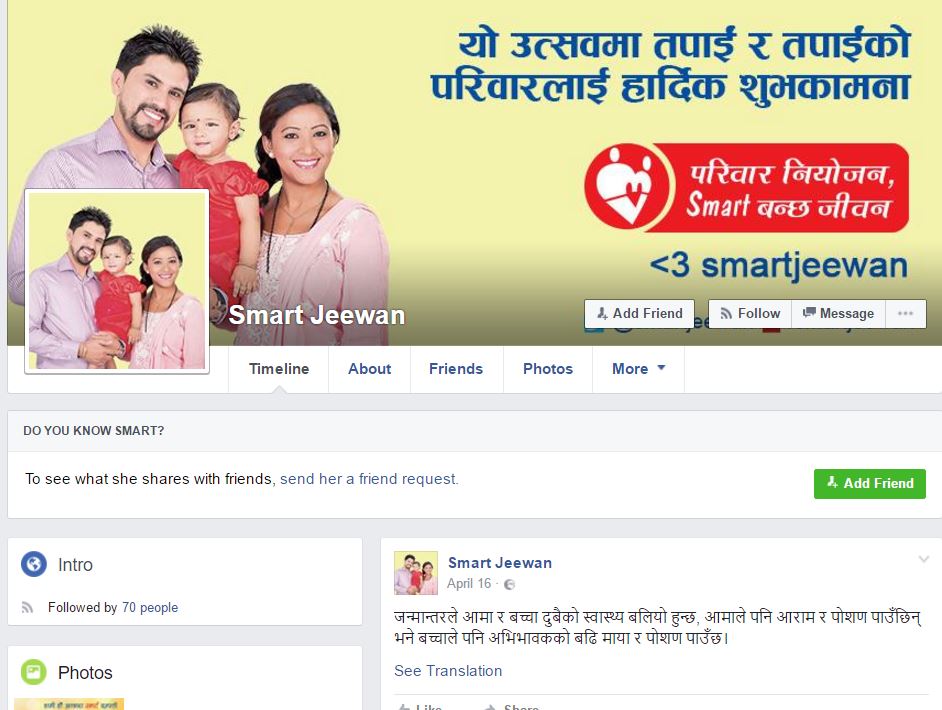The goal of the recent Next Generation “Smart Life” Family Planning Campaign is to increase modern contraceptive use among young, low-parity couples (those with one or two children).
Dubbed “Smart Life,” the campaign takes a multi-channel approach, with high-quality television and radio spots airing across Nepal. The aim is to increase the use of modern contraceptives among young married couples, including both the newly married and young parents, or “1000-day” couples.
In describing the vision and positioning of the family planning campaign, Ron Hess, project director of HC3 in Nepal, says, “Family planning is a means to an end. We must start by asking, ‘Why family planning?’ People here give many reasons why they want to manage their number of children: to provide them better care and nurture, a better home and, very importantly, a better education. In short, parents in Nepal want a brighter future for their children, as parents do the world over. The current campaign respects these aspirations – placing the ‘why’ of family planning first, then offers family planning solutions as ‘smart’ means toward these ends.”
Banner photo: Mothers with their children in Nepal. © 2013 Valerie Caldas/ Johns Hopkins University Center for Communication Programs, Courtesy of Photoshare
Timeline
Inquire
While gains in family planning (FP) and reducing unmet need have been made among certain segments of the population, young and newly married Nepali couples, those wishing to limit childbirth, or those in need of birth spacing, are lagging behind.
According to the Nepal Demographic and Health Survey (2011):
- 56 percent of women of reproductive age are below 30 years of age
- Only 12 percent use FP to delay the birth of their first child
- Less than 32 percent use FP to space their second child after the first birth
- Fewer than 13 percent are using FP within two months after delivery
One of the Millenium Development Goals for Nepal was a contraceptive prevalence rate (CPR) of 67% by 2015. The CPR had stagnated at 44% between 2006 and 2011 and the total fertility rate declined from 3l1 in 2006 to 2.6 in 2011. There was found to be a high unmet need for FP among migrants, married adolescents, and socially excluded groups, and many missed opportunities for promoting FP.

The formative research consisted of sixty in-depth interviews on attitudes, norms, experiences, and processes that influence contraceptive use.
Participants included:
- Unmarried women and men
- Married women and men
- Mothers-in-law
- Migrants
- Health workers and FCHVs
- Influential community members
Major highlights from the formative research were:
- Shared motivations: Fertility management is placed within the larger context of other parental care roles and practices
- Cooperation: Fertility management is typically a cooperative decision
- Family planning was related to shared goals for family and future
- There were distinct stages when couples reported using family planning
Design the Strategy
The strategic objective of the Smart Couple campaign was to:
- Increase modern contraceptive use among ‘1000-day Couples’, or young, low-parity women and men, specifically
- Increase age of first birth (AFB)
- Improve timing of FP use after delivery (PPFP)
- Increase optimal birth-spacing practices (HTSP)
- Increase long-term method use
- Reduce unmet need among Marginalized and Disadvantaged Groups (MDAGs)
- Improve contraceptive use dynamics among migrants (timing of initiation, discontinuation)
The strategy for the Smart Couple campaign was designed using the social-ecological model of behavior change.
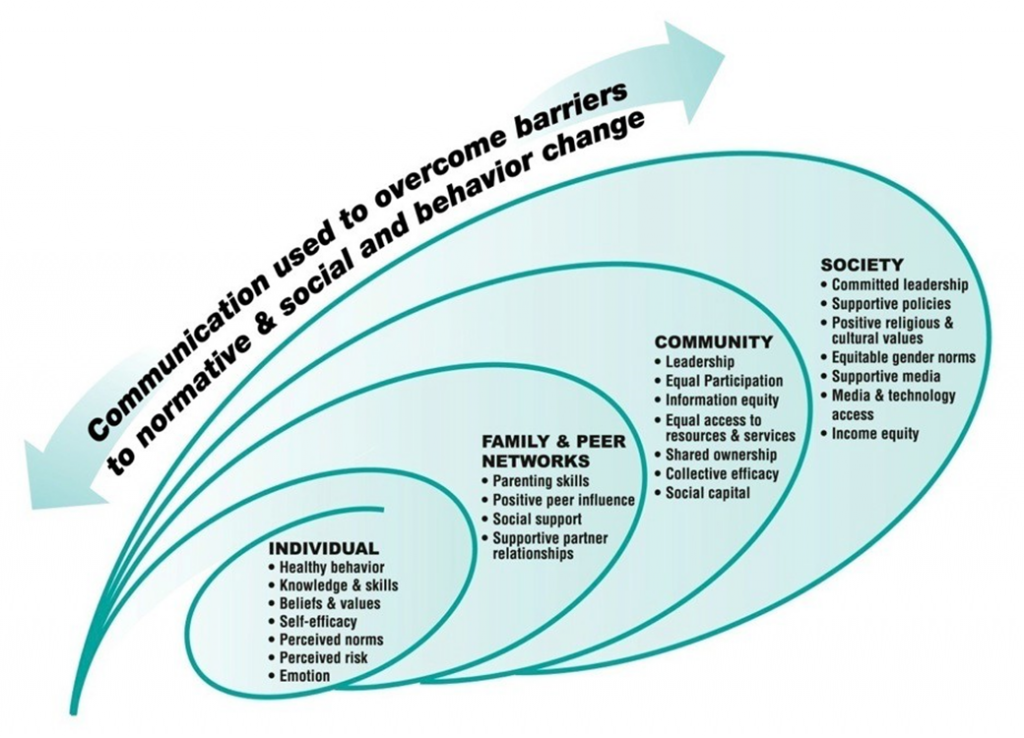
The campaign approach was to:
- Reposition Family Planning as the smart, healthy choice allowing couples to achieve success for themselves and their children
- Be aspirational, encouraing a better life based on smarter life choices
- Institute a brand to guide program and to tie all aspects together
- Encourage couples to communicate with their partners, peers, elders, health providers, community health workers, etc.
The campaign approach is illustrated below
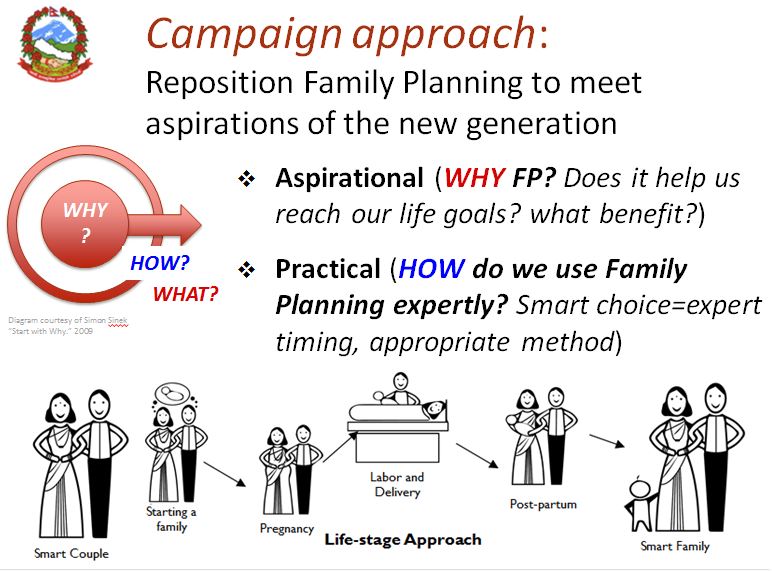
The strategy’s action plan was to encourage couples to:
- Establish early family planning behaviors to delay first birth
- Avoid unwanted postpartum pregnancy
- Space births successfully
- Encourage couples to know the facts about FP
- Encourage action NOW
This would not only help to improve maternal and child health outcomes in the short term, but would establish family planning use as a behavioral norm and, thus, affect longer-term fertility trends. The campaign, through its community programs in the districts, also focuses on families of migrant workers and people from marginalized and disadvantaged communities.
Create and Test
Pretesting found the word “Smart” has entered the local vernacular in Nepal in association with “new technology.” Additionally, “Smart Couple” was associated to the concept of mutual understanding, along with a bright and intelligent future. Consequently, the “Smart Couple” campaign seeks to encourage modern contraceptive use earlier among young couples, as well as to increase space between the first and second child by using a family planning method postpartum.
- Smart Couple Nepal Press Release
- Smart Couple Nepal Family Planning TV Spots
- Smart Couple Nepal Family Planning Posters
- Smart Couple Nepal Booklets/Brochures
- Smart Couple Nepal Wave-I TVC Pre-test Report
- Smart Couple Nepal Campaign Wave II Materials Pre-test Report
- Smart Couple Nepal Advocacy Brochure
- Smart Couple Nepal Campaign Word Testing Report
- Smart Couple Nepal Campaign Pamphlet, Poster Pretesting Report
- Smart Couple Nepal campaign Wave-II TVCs, Badhai Booklet and IPCC modules pre-testing report
Mobilize and Monitor
LAUNCH
The launch of the Smart Life campaign, on August 21, 2015, included speeches by the Health Minister, Ministry of Health, the Secretary of Health, the Director General of the Department of Health Sciences, and the USAID Mission Director, among others.
The event was MC’d by a celebrity couple, Malvika & Riaz (Ms. Nepal and her husband, dance instructor), and there were 175 attendees. The event was telecast live by Nepal TV, and there was national press coverage.
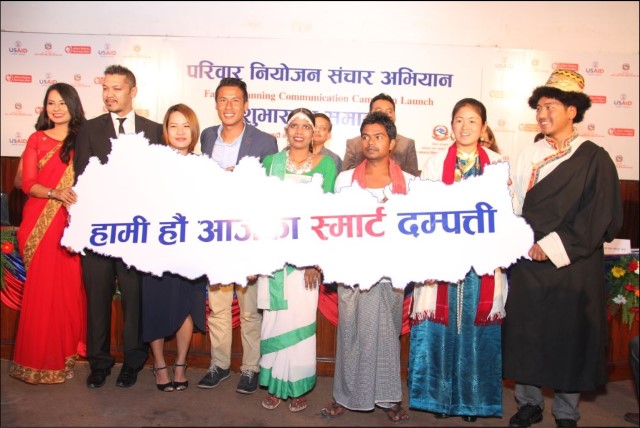
The campaign takes a fully integrated marketing approach. TVC placements cover all major national television channels in news and entertainment programs and have been pulsed over time. The media plan for radio commercials have followed a similar pattern, with placements in national radio stations, major national FM stations and all national FM networks to saturate coverage across the nation. The hoarding boards have been placed along major national highways and in high-traffic locations in focal JHU-HC3 Program districts. The reach of the campaign, with endorsement of the celebrities, was increased significantly through social media, mainly YouTube and Facebook.
DISTRICT CAMPAIGNS
The District Campaigns (13 focal districts) goals were:
- Maximize contacts among eligible couples (newlyweds and 1000-day couples) through skilled referral agents (FCHVs and Peer Educators)
- Increase referrals from community to “Hamro Swasthya Kendra” (Our Health Center)
- Enhance Quality of Counseling (IPC-C) and FP Services provided by Health Workers at “Hamro Swasthya Kendra”
The district model:
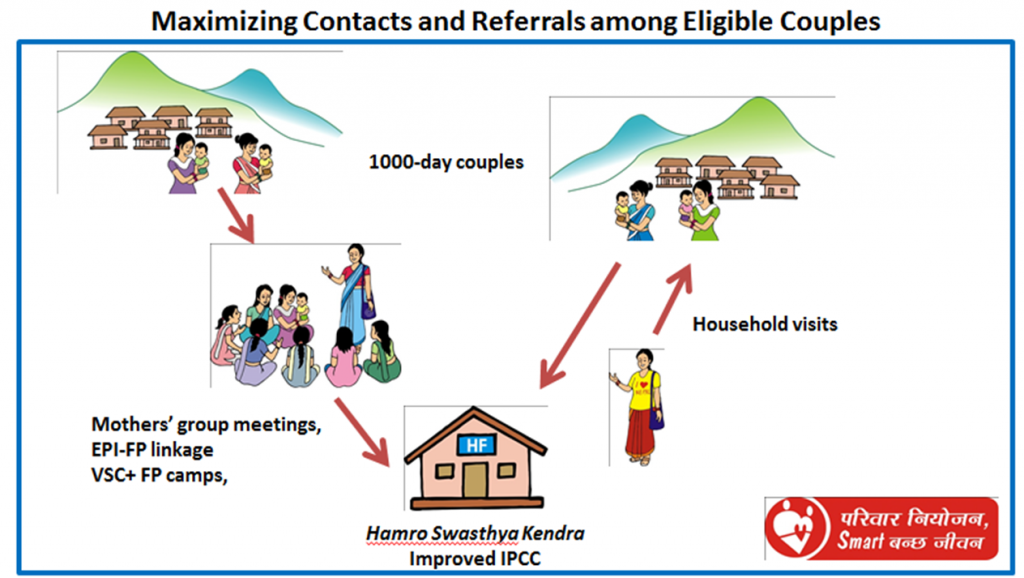
District activities included:
- Systematically contacting and referring “1000-Day” couples:
- Improved IPC-Counseling at Hamro Swasthya Kendra (HFs)
- Active FP service promotion
- Regional, large-scale “Smart Couple” PR events
- Local “Smart Couple” Celebration events
- Street dramas, community school programs
- Local FM airing of Smart Jeewan campaign spots, Radio Help Desk
- Continuous coordination w DHO, DPAC, RHCC, HFOMCs, etc.
Regional events were also held – these were called Regional “Smart Jeewan” Melas and included leadership support; celebrity ‘infotainment,’ and a family-friendly atmosphere. Attendance was impressive, and all were broadcast live:
- Western Region (Kaski): ~5000
- Central Region (Chitwan): ~10,000
- Midwestern (Nepalganj): ~20,000
- Far Western (Kanchanpur): ~30,000

Evaluate and Evolve
The social media results (social media coverage began October 18, 2015):
- Active involvement in social media since October 18th, 2015
- Cross-Promotional Platform
- Total FB users – 5,800,000
- Total SmartJeewan page reach in Facebook – 6,134,809 (repeated)
- Smart Dampati FB Campaign ad reach – 807,100
- Newly married video reach – 574,800
- Festival greeting video – 299,000
- Shiva Pariyar’s infotainment in Kanchanpur – 153,200
- Sugam Pokharel’s performance in Nepalgunj during launch of app – 12,200
- Users of Smart Dampati App – 6,031
- Successful upload of photo – ~ 2,500
Nationwide, in 13 focal districts, the campaign was found to have reached 58% of adults (Source: Sharecast Survey, Dec 2015)
Date of Publication: April 20, 2022

